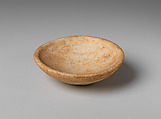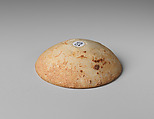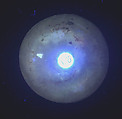On loan to The Met The Met accepts temporary loans of art both for short-term exhibitions and for long-term display in its galleries.
Marble bowl
Technical Analysis: Ultraviolet-induced visible luminescence examination, optical microscopy
This small, intact marble bowl consists of a clearly defined rim and small base. The exterior of the rim is undercut by a smooth groove. A shallow circular cavity picked out of the bottom of the vessel comprises its base. Its rather small size allows its assignment to the saucer type and the formation of its thickened rim to subvariety B, in Gavalas’s typology.(1) L.2022.38.86 seems to be similar in size.
The surface of the bowl has brownish accretions overall. There are long scratches on the interior and a very small loss to the otherwise intact rim. A shallow fissure is visible on the underside, as well as areas of weathering or pitting. The central area of the base appears to have a shallow, slightly grey fill that measures approximately 4 cm across and appears violet under ultraviolet-induced visible luminescence examination.
Georgios Gavalas and Wendy Walker
(1) Gavalas, Giorgos. 2018. “The Stone Vessels” in C. Renfrew, O. Philaniotou, N. Brodie, G. Gavalas and M.J. Boyd, eds. The Sanctuary on Keros and the Origins of Aegean Ritual Practice, Vol. III: The Marble Finds from Kavos and the Archaeology of Ritual, McDonald Institute Monographs, pp. 263-4 and pp. 269-273, fig. 4.3. This type of vessel is briefly discussed by Getz-Gentle, Pat. 1996. The Stone Vessels of the Cyclades in the Early Bronze Age. pp. 99-105, pl. 50-55, University Park: The Pennsylvania State University Press. See pl. 50 a and c for the closest parallel in size.
This image cannot be enlarged, viewed at full screen, or downloaded.
This artwork is meant to be viewed from right to left. Scroll left to view more.





